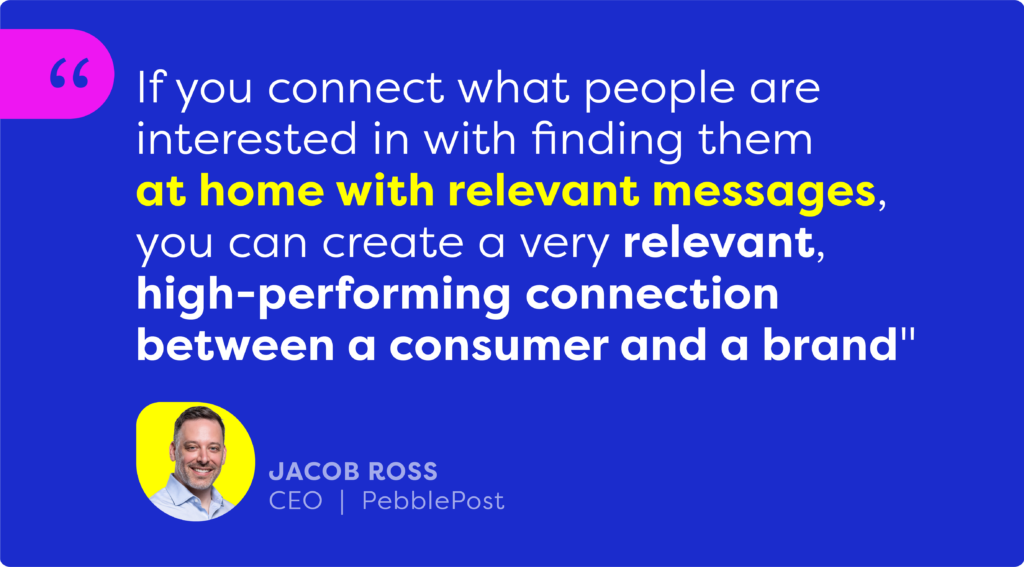Digital has long been devouring marketing. But then came a plot twist.
After hearing about the rise of all things digital, savvy marketers are now using offline channels for online marketing. Enter the term “phygital”, experiences that can add value to consumers by blending digital experiences with physical ones. This comes when more people spend time at home, allowing marketers to engage them with digital and physical messages and offers.
Jacob Ross, CEO of PebblePost, recently spoke with Benjamin Shapiro on MarTech Podcast about the role of offline media and the future of marketing.
As marketers face immense pressure to deliver results amidst economic uncertainty, rising customer acquisition costs, and privacy changes, they need new ways to evaluate and measure their efforts. Programmatic Direct Mail marketing is one of those new approaches.
“When I met the PebblePost team four years ago, I was blown away because what they had done is they had figured out how to reinvent traditional direct mail,” Ross says.
What is Programmatic Direct Mail? Using digital principles in a traditional offline format, Programmatic Direct Mail is a marketing channel that leverages machine learning and automation informed by massive sets of real-time intent and offline data to engage consumers at home with highly-relevant physical media. This lets marketers spend their budgets on individuals likely in-market for their products.
Here are three critical takeaways from Ross and Shapiro’s conversation about the rise of offline digital channels and how brands can use them to future-proof their marketing strategies.
- Programmatic Direct Mail lets you meet consumers where they are
People now spend more and more time online researching what to purchase, from their next vacation to their next car. And because so many of us still work remotely, those searches happen on connected devices at home. Brands can now reach their target audiences where they check their email and mail—the ultimate example of “phygital” marketing.
“If you connect what people are interested in with finding them at home with relevant messages, you can create a very relevant, high-performing connection between a consumer and a brand,” Ross says.
This is not unlike other traditional offline channels we’ve seen digitized, such as linear TV to connected TV, out-of-home to digital out-of-home, and radio to music and podcast apps.
Programmatic Direct Mail does the same for direct mail using digital signals, algorithms, and measurement.

- Programmatic Direct Mail marketing is highly measurable
Everything at PebblePost is built around relevance, Ross says.
There was junk print mail before junk email. PebblePost’s Programmatic Direct Mail process cuts through this noise by working with brands to gauge individuals’ interest in a product and purchase intent.
Programmatic Direct Mail with PebblePost starts by connecting massive sets of online and offline intent and purchase data to households and using that data to train sophisticated machine learning models on who might be the best person to receive a specific piece of mail from a specific brand. This is important because postcard advertising can be expensive, and rising USPS postage rates and paper costs add to this expense.
Then, PebblePost’s automated workflows and dynamic print and mail network ensure the direct mail piece gets sent to the consumer at the right time with the right message. During this process, a hold-out group is created in order to measure the incremental impact of this marketing on whether or not it has the intended impact on consumer purchase decisions.
To close the loop, the brand then shares transaction data containing the households that purchased certain items on specific dates. PebblePost uses this data to run a a match-back analysis. If a household received a piece of mail and subsequently made a purchase as measured by customer acquisition costs (CAC) or return-on-ad spend (ROAS) goals, it is attributed accordingly. This end-to-end process usually results in a more holistic sense of performance.
“The beauty of direct mail is that everything is trackable down to a unique postal address,” Ross says.
While other channels might mimic the Programmatic Direct Mail approach, the measurement can vary. TV objectives blend performance and awareness, for instance. With Programmatic Direct Mail, PebblePost tries to keep it data-driven, simple, and targetable.
“One of the conversations that we’ve been having with our brands is, could we help using direct mail tactics measure the impact of advertising in other channels?” Ross says.
- Programmatic Direct Mail is a solution for the cookieless future
We’ve entered the era of “privacy soup” in digital marketing. From third-party cookie deprecation and browser changes to additional state and even federal privacy laws on the horizon, brands need new addressable marketing channels that make it possible to engage consumers with relevance and respect at scale.
This is why the household address will become even more critical in a cookieless future. As new alternative solutions to third-party cookies remain in development and the future of browser and device identifiers remains unclear, targeting and measuring at the household level is one of the most straightforward paths. Programmatic Direct Mail’s ability to connect online intent to a consumer at a physical address will help marketers continue reaching consumers in targeted, privacy-first ways while avoiding wasted spend.
Ross says the general group of offline-to-digital solutions is probably underweight in a marketer’s plan today. But that’s because they’re taking a data-driven test-and-learn approach to these channels, which he agrees with.
“Sometimes what’s old becomes new again,” Ross says. “And sometimes there is a need to investigate in new ways, new channels.”
You can hear the entire conversation between Ross and Shapiro here.



